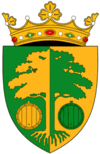Strășeni district
| Strășeni | |||
|---|---|---|---|
| District (Raion) | |||
|
|||
 |
|||
| Country |
|
||
| Administrative center (Oraș-reședință) |
Strășeni |
||
| Government | |||
| • Raion President | Petru Voloșciuc (PLDM), since 2011 | ||
| Area | |||
| • Total | 730 km2 (280 sq mi) | ||
| Population (2012) | |||
| • Total | 91,500 | ||
| • Density | 125.3/km2 (325/sq mi) | ||
| Time zone | EET (UTC+2) | ||
| • Summer (DST) | EEST (UTC+3) | ||
| Postal Code | 237 | ||
| Area code(s) | +373 37 | ||
| Car plates | ST | ||
| Website | http://www.straseni.md | ||
Strășeni is an administrative district (Moldovan: raion) in the central part of Moldova. Its administrative center and leading city is Strășeni. As of 1 January 2011, its population was 91,100. The other principal town is Bucovăț, 26 km (16 mi) to the north of the Moldovan capital. Otherwise the district is divided between rural communities.
Strășeni is a toponym, of origin polysemantic as legends show in time, the name derived from the word "horrible" (in Romanian "strașnic") and the echo of these events materialize. In name of a hamlet of the forest Codri. Or in another version, outlaws hope nobleman, who travels on the road to Chișinău (19th century), so places were Scary. Another treatment of the toponym, as the traditional occupations linked to the natives. The parties were of Strășeni craftsmen, carpenters, just like a great eaves (in Romanian stresina).
The present territory of the district is inhabited since the stone age, 30-20.000 BC. Localities with the oldest historical attestation are Căpriana, Dolna, Lozova and Vorniceni, they are first attested in 1420. Căpriana monastery in 1429 received the status of the monastery. The present territory of the district Straseni, was part of the medieval lands Lăpușna County and Orhei County boundary of which is on the Bîc River. In 1545 is remembered by scribes, Strășeni district center. In the 16th-18th centuries, the district develop both economic (trade, agriculture, forestry) and cultural (built monasteries and churches), as there has been a major increase of population. In 1812, after the Russo-Turkish War (1806-1812), is the occupation of Basarabia, Russian Empire during this period (1812-1917), there is an intense russification of the native population. In 1918 after the collapse of the Russian Empire, Bessarabia united with Romania in this period (1918-1940, 1941-1944), the district is part of the Chișinău County. In 1940 after Molotov-Ribbentrop Treaty, Basarabia is occupied by the USSR. In 1991 as a result of the proclamation of Independence of Moldova, part and residence of the Chișinău County (1991-2003), and in 2003 became administrative unit of Moldova.
...
Wikipedia


